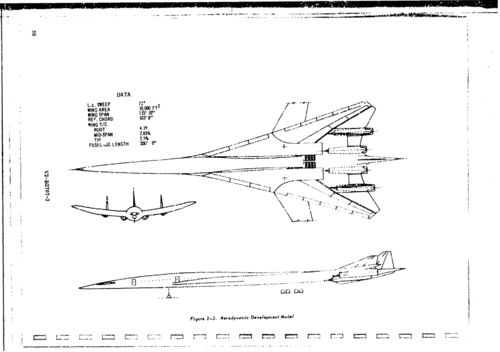Yes indeed, thks Blackkite San. Seems to be a post SST stuf. But still looks like Boeing.
Can't find from where it's coming.
Can't find from where it's coming.
Can someone identify these two and from which document they come from ? :
View attachment 630614
View attachment 630613
Found it on a Facebok page with no hint of from where it came (I hate facebok), Certainly looks very Boeing to me tho.
Peter "have you ever seen a grown man naked?" Graves is in this? The audience must have been in stitches when he appeared.

This model is at the Northwest Airline History center :
View attachment 632397
View attachment 632398
First time I see a twin tails Boeing SST, don't know if its a genuine Boeing stuff...
Maybe an old -100 scale model, restored with twin tails ?
Not sure about the wings... some 2707-100 models were made with wings swept back fixed, the whole thing molded in a single piece , with only a thin black line painted to separate the tailplane from what was supposed to be the swing wing.Since it doesn't appear to have swing wings, it looks more like a fantasy hybrid of the 2707 and earlier B-70 derivative concepts.
Magnificent artwork and very beautiful aircraft.I'm not sure if I posted in SPF before but here it is my L-2000 artwork.

Some weird intakes ! Wonder how the spike shock cone would do with squared intake shape.A 1966? Fairchild Republic SST concept art:


We have a good topic already on SSTs, but the gist of it was the L-2000 was probably buildable, but (like Concorde) could not be competitive with subsonic airliners. The premise of the 2707 was that using recent NASA research, you could have an SST that was able to somewhat compete with conventional airliners in terms of operating costs. It turned out that the fabled 2707 with VG wings was unbuildable with the technology of the time; the eventual fixed wing 2707 was no more competitive than L-2000 or Concorde.
Some creative accounting assuming SSTs would make more flights per day (due to being faster) and therefore make similar money to a subsonic airliner despite higher costs was probably never going to be correct - it would have needed roughly similar pricing, no stress-based impacts on airframe life from supersonic flight, and no additional maintenance costs, none of which seems especially likely.
| Aircraft | Flight Number | Departure (UTC) | Arrival (UTC-5) | Arrival (UTC) | Gate to gate time | Great circle ground speed (knots) | Implied headwind |
| Concorde | BA173 | 0915 | 0800 | 1300 | 4:45 | 631 | 84.5 |
| 747 | BA175 | 1100 | 1335 | 1835 | 7:35 | 395 | 27.0 |
| Concorde | BA171 | 1115 | 1000 | 1500 | 4:45 | 631 | 84.5 |
| VC.10 | BA179 | 1800 | 2050 | 0150 | 7:50 | 382 | 28.5 |
| Aircraft | Flight Number | Departure (UTC-5) | Departure (UTC) | Arrival (UTC) | Gate to gate time | Great circle ground speed (knots) | Implied tailwind |
| VC.10 | BA178 | 0930 | 1430 | 2120 | 6:50 | 439 | 28.5 |
| Concorde | BA172 | 1000 | 1500 | 1845 | 3:45 | 800 | 84.5 |
| Concorde | BA170 | 1215 | 1715 | 2100 | 3:45 | 800 | 84.5 |
| 747 | BA176 | 2200 | 0300 | 0940 (next day) | 6:40 | 449 | 27.0 |
Oooo, that Lufthansa drawing is gorgeous..Found courtesy of google images the Boeing 2707-300 in Pan Am and Lufthansa colours.
They appear to be original pictures sent to the airlines by Boeing.
The US kit maker Revell issued a two plane Boeing SST set in the 60s based on this variant.
Model 733-94What is the aircraft model located top of this large picture?

